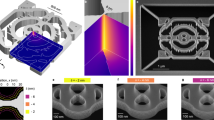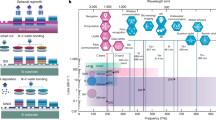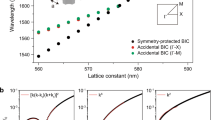Abstract
Confinement of light to small volumes has important implications for optical emission properties: it changes the probability of spontaneous emission from atoms, allowing both enhancement and inhibition. In photonic-bandgap (PBG) materials1,2,3,4 (also known as photonic crystals), light can be confined within a volume of the order of (λ/2n)3, where λ is the emission wavelength and n the refractive index of the material, by scattering from a periodic array of scattering centres. Until recently5,6, the properties of two- and three-dimensional PBG structures have been measured only at microwave frequencies. Because the optical bandgap scales with the period of the scattering centres, feature sizes of around 100 nm are needed for manipulation of light at the infrared wavelength (1.54 µm) used for optical communications. Fabricating features this small requires the use of electron-beam or X-ray lithography. Here we report measurements of microcavity resonances in PBG structures integrated directly into a sub-micrometre-scale silicon waveguide. The microcavity has a resonance at a wavelength of 1.56 µm, a quality factor of 265 and a modal volume of 0.055 µm3. This level of integration might lead to new photonic chip architectures and devices, such as zero-threshold microlasers, filters and signal routers.
This is a preview of subscription content, access via your institution
Access options
Subscribe to this journal
Receive 51 print issues and online access
$199.00 per year
only $3.90 per issue
Buy this article
- Purchase on Springer Link
- Instant access to full article PDF
Prices may be subject to local taxes which are calculated during checkout




Similar content being viewed by others
References
Joannopoulos, J. D., Villeneuve, P. R. & Fan, S. Photonic crystals: putting a new twist on light. Nature 386, 143–149 (1997).
Soukoulis, C. M. (ed.) Photonic Band Gap Materials (Kluwer, Dordrecht, (1996)).
Joannopoulos, J. D., Meade, R. D. & Winn, J. N. Photonic Crystals (Princeton, New York, (1995)).
Yablonovitch, E. Photonic band-gap structures. J. Opt. Soc. Am. B 10, 283–295 (1993).
Kraus, T., De La Rue, R. & Band, S. Two-dimensional photonic bandgap structures operating at near-infrared wavelengths. Nature 383, 699–702 (1996).
Grüning, U., Lehmann, V., Ottow, S. & Busch, K. Macroporous silicon with a complete two-dimensional photonic bandgap centered at 5 µm. Appl. Phys. Lett. 68, 747–749 (1996).
Fan, S., Winn, J. N., Devenyi, A., Chen, J. C., Meade, R. D. & Joannopoulos, J. D. Guided and defect modes in periodic dielectric waveguides. J. Opt. Soc. Am. B 12, 1267–1272 (1995).
Yang, I. Y. et al. Combining and matching optical, e-beam and x-ray lithographies in the fabrication of Si CMOS circuits with 0.1 and sub-0.1 µm features. J. Vacuum Sci. Technol. B 13, 2741–2744 (1995).
Foresi, J. S. thesis, MIT (1997).
Yokoyama, H. & Brorson, S. D. Rate equation analysis of microcavity lasers. J. Appl. Phys. 66, 4801–4805 (1989).
Acknowledgements
This work was supported by the Air Force Office of Scientific Research (AFOSR), the National Science Foundation (NSF-MRSEC) and the Army Research Office (ARO).
Author information
Authors and Affiliations
Corresponding author
Rights and permissions
About this article
Cite this article
Foresi, J., Villeneuve, P., Ferrera, J. et al. Photonic-bandgap microcavities in optical waveguides. Nature 390, 143–145 (1997). https://doi.org/10.1038/36514
Received:
Accepted:
Issue Date:
DOI: https://doi.org/10.1038/36514
This article is cited by
-
Efficient side-coupling configuration for photonic crystal nanobeam cavities with micro-ring resonators
Optical and Quantum Electronics (2024)
-
Activating cavity by electrons
Communications Physics (2023)
-
Ultra-efficient generation of time-energy entangled photon pairs in an InGaP photonic crystal cavity
Communications Physics (2023)
-
Transmission properties of thue-morse, fibonacci and fixed length photonic crystals: comparing the planar and annular geometries
Optical and Quantum Electronics (2023)
-
Noisy propagation of Gaussian states in optical media with finite bandwidth
Scientific Reports (2022)
Comments
By submitting a comment you agree to abide by our Terms and Community Guidelines. If you find something abusive or that does not comply with our terms or guidelines please flag it as inappropriate.



